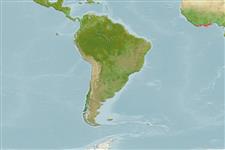(كوسه ها و سپرماهيان) (sharks and rays) >
Myliobatiformes (Stingrays) >
Zanobatidae (Panrays)
Etymology: maculatus: Name from Latin 'macula' for spotted; referring to its blotched colour pattern..
Environment: milieu / climate zone / depth range / distribution range
بوم شناسي
دريايي نزديك كف زي; تغييرات عمق 1 - 30 m (Ref. 116736). Tropical; 6°N - 5°S, 8°W - 11°E (Ref. 114953)
Eastern Central Atlantic: Gulf of Guinea, from Ivory Coast to Gabon.
Size / Weight / سن
Maturity: Lm ? range ? - ? cm
Max length : 35.9 cm TL جنس نر / بدون خواص جنسي; (Ref. 116736)
توصيف مختصر
كليدهاي شناسايي | ريخت شناسي | ريخت ستجي بوسيله انداره گيري
This species is distinguished from its congener (Zanobatus schoenleinii) by the following combination of characters: dorsal surface of disc is brownish to reddish brown, with numerous dark brown blotches, and sometimes surrounded by a network of whitish dots; the ventral surface of disc is pale creamy white or orange-brown, with conspicuous dark brown posterolateral margins; the crown of dermal denticles of dorsal surface spearhead-shaped; dorsal surface with enlarged thorny denticles are more numerous and stronger, in parallel rows on trunk and in concentric semi-circular rows on pectoral fins; tooth rows in upper jaw 54-64 ; predorsal vertebrae 36-44 (mode 39) (Ref. 116736).
Lives mostly on sandy bottoms (Ref. 116736).
Life cycle and mating behavior
Maturities | تولید مثل | Spawnings | Egg(s) | Fecundities | توزاد ( لارو)
Séret, B., 2016. Zanobatus maculatus, a new species of panray from the Gulf of Guinea, eastern central Atlantic (Elasmobranchii: Batoidea: Zanobatidae). Zootaxa 4161(4):509-522. (Ref. 116736)
وضعيت در فهرست قرمز IUCN (Ref. 130435)
خطر برای انسان ها
Harmless
استفاده انسانی
ابزارها
گزارش های ويژه
بارگيری XML
منابع اينترنتي
Estimates based on models
Phylogenetic diversity index (Ref.
82804): PD
50 = 0.7500 [Uniqueness, from 0.5 = low to 2.0 = high].
Bayesian length-weight: a=0.01000 (0.00244 - 0.04107), b=3.04 (2.81 - 3.27), in cm total length, based on all LWR estimates for this body shape (Ref.
93245).
Trophic level (Ref.
69278): 3.4 ±0.5 se; based on size and trophs of closest relatives
Fishing Vulnerability (Ref.
59153): Low to moderate vulnerability (26 of 100).
